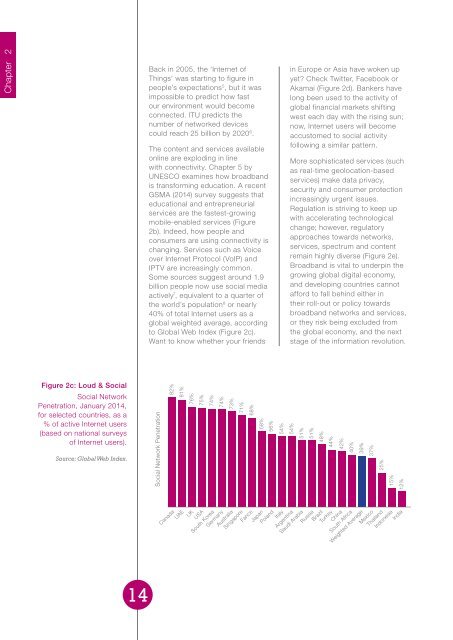DI8xz
DI8xz
DI8xz
Create successful ePaper yourself
Turn your PDF publications into a flip-book with our unique Google optimized e-Paper software.
Chapter 2Back in 2005, the ‘Internet ofThings’ was starting to figure inpeople’s expectations 5 , but it wasimpossible to predict how fastour environment would becomeconnected. ITU predicts thenumber of networked devicescould reach 25 billion by 2020 6 .The content and services availableonline are exploding in linewith connectivity. Chapter 5 byUNESCO examines how broadbandis transforming education. A recentGSMA (2014) survey suggests thateducational and entrepreneurialservices are the fastest-growingmobile-enabled services (Figure2b). Indeed, how people andconsumers are using connectivity ischanging. Services such as Voiceover Internet Protocol (VoIP) andIPTV are increasingly common.Some sources suggest around 1.9billion people now use social mediaactively 7 , equivalent to a quarter ofthe world’s population 8 or nearly40% of total Internet users as aglobal weighted average, accordingto Global Web Index (Figure 2c).Want to know whether your friendsin Europe or Asia have woken upyet? Check Twitter, Facebook orAkamai (Figure 2d). Bankers havelong been used to the activity ofglobal financial markets shiftingwest each day with the rising sun;now, Internet users will becomeaccustomed to social activityfollowing a similar pattern.More sophisticated services (suchas real-time geolocation-basedservices) make data privacy,security and consumer protectionincreasingly urgent issues.Regulation is striving to keep upwith accelerating technologicalchange; however, regulatoryapproaches towards networks,services, spectrum and contentremain highly diverse (Figure 2e).Broadband is vital to underpin thegrowing global digital economy,and developing countries cannotafford to fall behind either intheir roll-out or policy towardsbroadband networks and services,or they risk being excluded fromthe global economy, and the nextstage of the information revolution.Figure 2c: Loud & SocialSocial NetworkPenetration, January 2014,for selected countries, as a% of active Internet users(based on national surveysof Internet users).Source: Global Web Index.Social Network Penetration82%81%76%75%74%74%73%71%68%58%56%54%54%51%51%48%44%42%40%39%37%25%15%12%CanadaUAEUKUSASouth KoreaGermanyAustraliaSingaporeFanceJapanPolandItalyArgentinaSaudi ArabiaRussiaBrazilTurkeyChinaSouth AfricaWeighted AverageMexicoThailandIndonesiaIndia14


